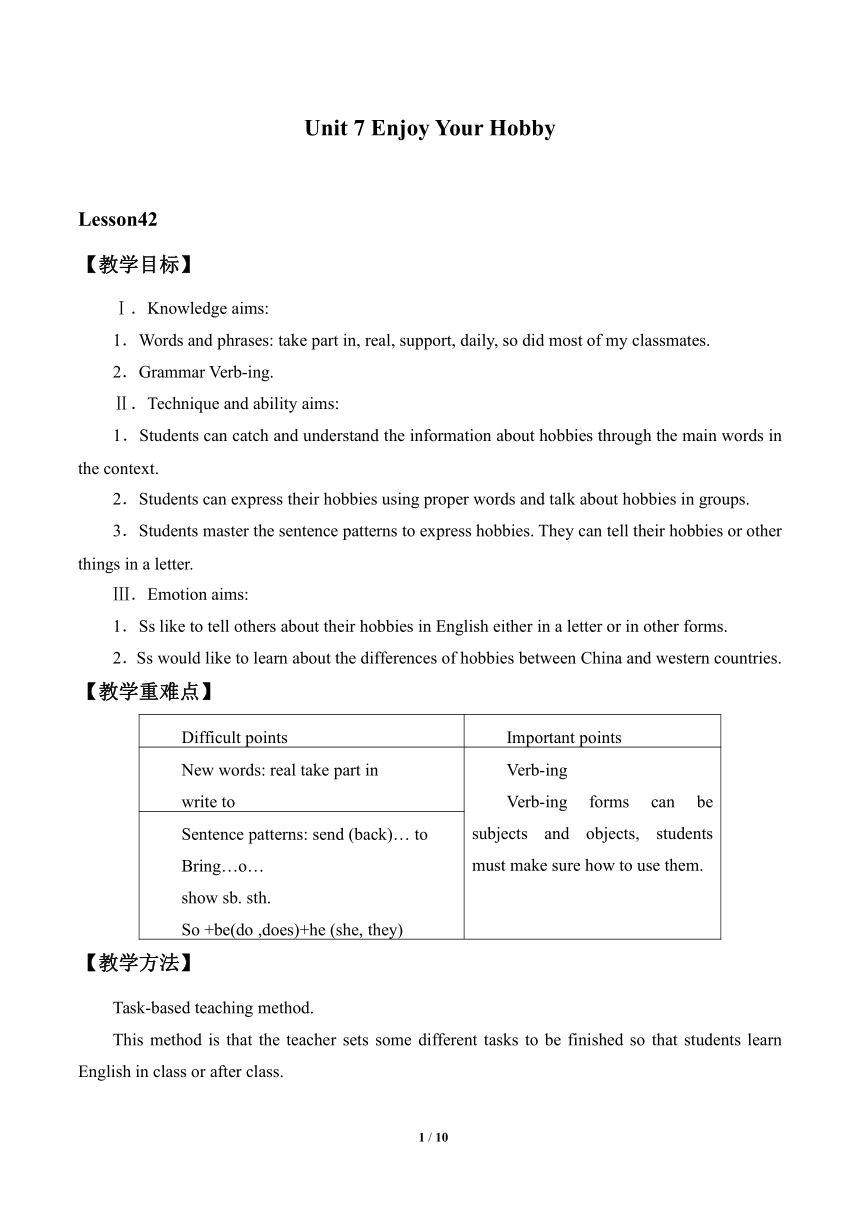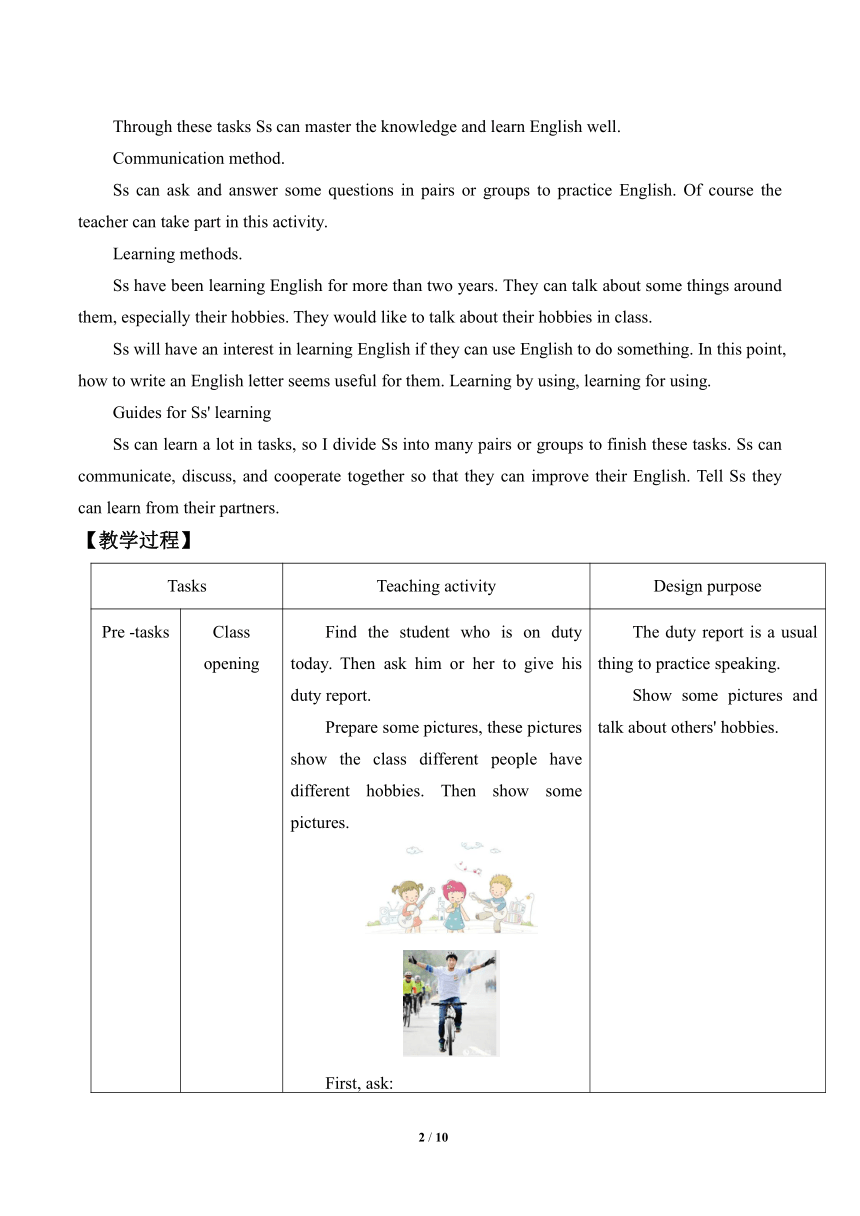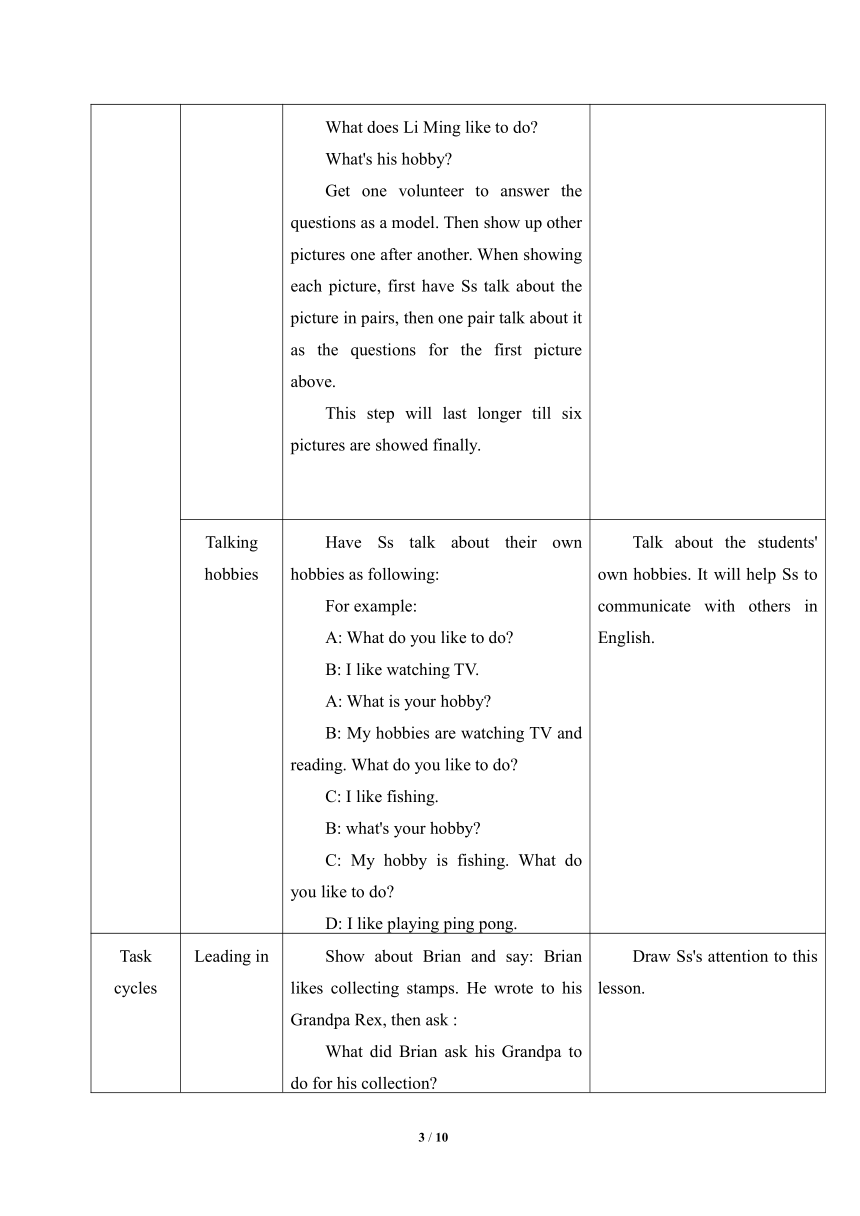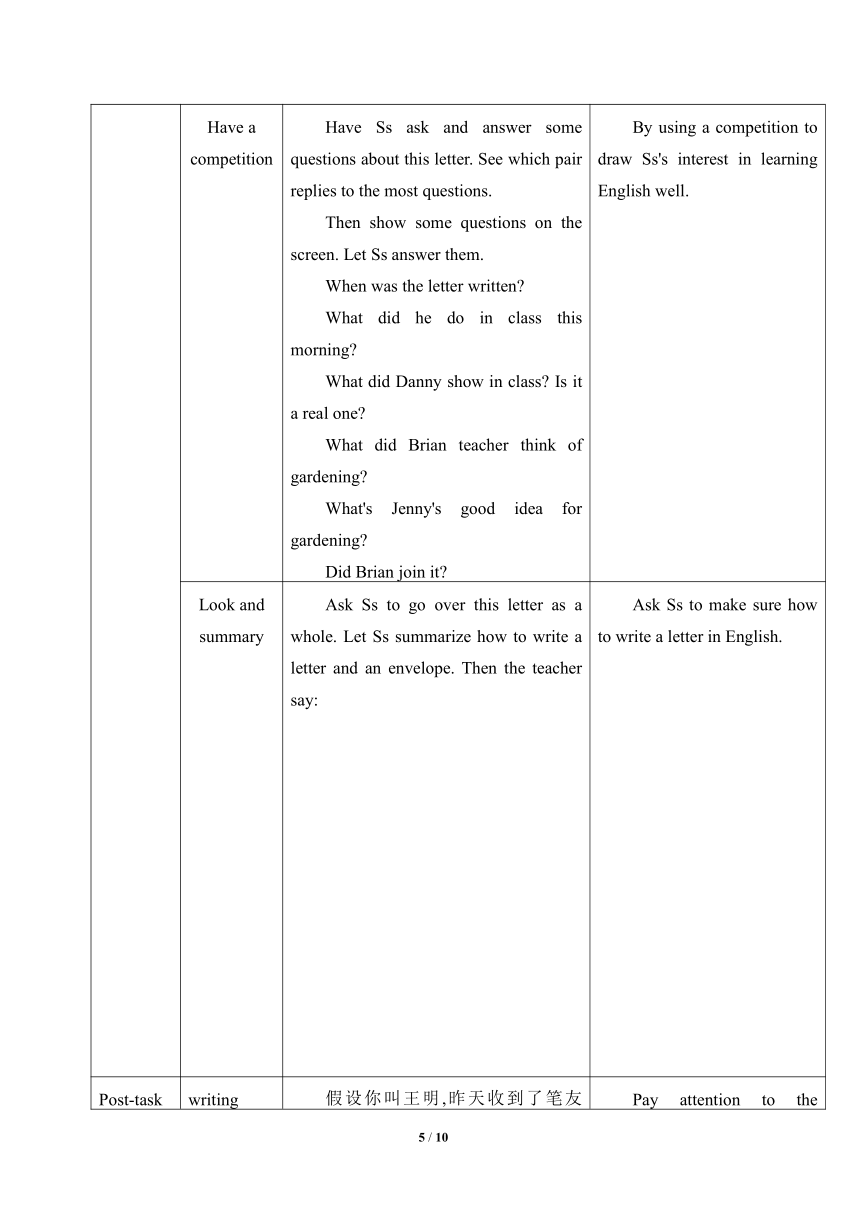冀教版八年级上册Unit 7 Enjoy Your Hobby 教案(表格式)
文档属性
| 名称 | 冀教版八年级上册Unit 7 Enjoy Your Hobby 教案(表格式) |  | |
| 格式 | doc | ||
| 文件大小 | 239.5KB | ||
| 资源类型 | 教案 | ||
| 版本资源 | 冀教版 | ||
| 科目 | 英语 | ||
| 更新时间 | 2022-10-11 14:53:02 | ||
图片预览





文档简介
Unit 7 Enjoy Your Hobby
Lesson42
【教学目标】
Ⅰ.Knowledge aims:
1.Words and phrases: take part in, real, support, daily, so did most of my classmates.
2.Grammar Verb-ing.
Ⅱ.Technique and ability aims:
1.Students can catch and understand the information about hobbies through the main words in the context.
2.Students can express their hobbies using proper words and talk about hobbies in groups.
3.Students master the sentence patterns to express hobbies. They can tell their hobbies or other things in a letter.
Ⅲ.Emotion aims:
1.Ss like to tell others about their hobbies in English either in a letter or in other forms.
2.Ss would like to learn about the differences of hobbies between China and western countries.
【教学重难点】
Difficult points Important points
New words: real take part inwrite to Verb-ingVerb-ing forms can be subjects and objects, students must make sure how to use them.
Sentence patterns: send (back)… toBring…o…show sb. sth.So +be(do ,does)+he (she, they)
【教学方法】
Task-based teaching method.
This method is that the teacher sets some different tasks to be finished so that students learn English in class or after class.
Through these tasks Ss can master the knowledge and learn English well.
Communication method.
Ss can ask and answer some questions in pairs or groups to practice English. Of course the teacher can take part in this activity.
Learning methods.
Ss have been learning English for more than two years. They can talk about some things around them, especially their hobbies. They would like to talk about their hobbies in class.
Ss will have an interest in learning English if they can use English to do something. In this point, how to write an English letter seems useful for them. Learning by using, learning for using.
Guides for Ss' learning
Ss can learn a lot in tasks, so I divide Ss into many pairs or groups to finish these tasks. Ss can communicate, discuss, and cooperate together so that they can improve their English. Tell Ss they can learn from their partners.
【教学过程】
Tasks Teaching activity Design purpose
Pre -tasks Class opening Find the student who is on duty today. Then ask him or her to give his duty report.Prepare some pictures, these pictures show the class different people have different hobbies. Then show some pictures.First, ask:What does Li Ming like to do What's his hobby Get one volunteer to answer the questions as a model. Then show up other pictures one after another. When showing each picture, first have Ss talk about the picture in pairs, then one pair talk about it as the questions for the first picture above.This step will last longer till six pictures are showed finally. The duty report is a usual thing to practice speaking.Show some pictures and talk about others' hobbies.
Talking hobbies Have Ss talk about their own hobbies as following:For example:A: What do you like to do B: I like watching TV.A: What is your hobby B: My hobbies are watching TV and reading. What do you like to do C: I like fishing.B: what's your hobby C: My hobby is fishing. What do you like to do D: I like playing ping pong. Talk about the students' own hobbies. It will help Ss to communicate with others in English.
Task cycles Leading in Show about Brian and say: Brian likes collecting stamps. He wrote to his Grandpa Rex, then ask :What did Brian ask his Grandpa to do for his collection Have Ss scan the letter and find the answer to the question. Draw Ss's attention to this lesson.
listening Play the tape for Ss to listen, then fill in the blanks using proper words and phrases to finish the questions below.1.Brian asked his Grandpa _____ the stamp ____ _____ to him for his hobby.2.In class everyone ____his or her favorite hobby ____school.3 Danny showed us____, it was____ one .I enjoyed Jenny's hobby best. Her hobby is_____.4.Our teacher says that gardening is enjoyable and easy to learn. Everyone can___ _____ _____gardening.5.Jenny had a very good idea. She said that we would ___ _a gardening club.6.Jenny and Brian joined the club, ________ most of our classmates.Key : 1.to send/ back to 2.brought / to 3.his family tree/ real / gardening 4.take part in 5.organize 6.So did This step for Ss is to practice Ss's listening.Ss can finish the uncompleted sentences by catching the main (or key) information.Ss need to write while listening to the text.
reading Play the tape one more time for Ss to listen. Ss follow the tape and repeat. Then have them read the letter in pairs, check each other's pronunciation in order to study from each other. Ss can learn from each other.
Have a competition Have Ss ask and answer some questions about this letter. See which pair replies to the most questions. Then show some questions on the screen. Let Ss answer them.When was the letter written What did he do in class this morning What did Danny show in class Is it a real one What did Brian teacher think of gardening What's Jenny's good idea for gardening Did Brian join it By using a competition to draw Ss's interest in learning English well.
Look and summary Ask Ss to go over this letter as a whole. Let Ss summarize how to write a letter and an envelope. Then the teacher say: Ask Ss to make sure how to write a letter in English.
Post-task writing 假设你叫王明,昨天收到了笔友David的信,得知他不久要到北京来学习中文.他想了解如何学好中文.请你用英文给他回复一封信介绍学习中文的体会和方法,提出你的建议,以及表达你帮助他学好中文的愿望Ask Ss write a letter to David, At last show the Ss' composition and help Ss to correct the wrong sentences. Here is a model.Sample:Dear David:I'm glad you'll come to Beijing to learn Chinese. Chinese is very useful, and many foreigners are learning it now. It's difficult for you because it's quite different from English. You have to remember as many Chinese words as possible. It's also important to do some reading and writing. You can watch TV and listen to the radio to practice your listening. Do your best to talk with people in Chinese. You can learn Chinese not only from books but also from people around you. If you have any questions, please ask me. I'm sure you'll learn Chinese well.Hope to see you soon in Beijing. Yours, Wang Ming Pay attention to the structure of an English letter.Write a letter to their friend and talk about something around them.
Doing exercise Is your hobby ______.A.play football B.playing the football C.playing soccer D.play the soccerMy brother _____the army last year.A.take part in B.become member C.joins D.joined.3.Can I _____ playing basketball (选项同上.)4.Tom did his homework last night. ________. A.So do I B.So am I C.So did I D.So does I5.Could you ___your phone___ me. I want to have a look.A.give/to B.show / to C.send/ for D.bring / back Check if Ss have mastered the important words or sentence patterns.
Homework 1.Write a letter about your hobby to your best friend.2.Do the Exercises in the activity book.3.Review the contents in this unit.
Language points:
1.Please send the stamp back to me for my collection.请把邮票寄回来让我收藏.
句中send 是动词,意思是“寄,送”,send back意思是寄回来,而send to是“寄给…”
I sent her a dictionary, but she sent it back to me.我寄给她一本词典,但是她给我寄回来了.
2.I showed my stamp collection to the class.我给同学们展示了我收藏的邮票.
class n.班级,(上)课,the class可以指班上的全体同学.
class也可作“班级”解,是可数的集合名词.常用作单数使用,谓语动词要用单数形式;如用作复数,则表示组成这个集体的一个个成员,谓语动词要用复数形式.
例句: The class has made noticeable improvement. ( http: / / dict. / search q=lj:class&ljtype=blng&ljblngcont=0&le=eng&keyfrom=dict.main.moreblng" \o "点击发音 )
这个班已有引人注目的进步.
The class are having a meeting.全班学生在开会
in class意为“在课堂上,在课上”,而in the class则表示“在班里”.
Listen carefully in class.上课认真听讲.
How many students are there in the class 班里多少学生
3.This morning, everyone in my class brought his or her favorite hobby to school.
今天上午,我们班里每个人都把自己最喜欢的爱好带到学校来了.
辨析: bring和take
(1)bring 指带过来.
bring sth./sb.to some place意思是“把某物、某人带到某地”.
Don't forget to bring your homework to school.别忘记把你的作业带到学校来.
(2)take指带走,或随身携带.
You should take your son away. He is too noisy.你应该把孩子带走,他太吵了.
Take an umbrella with you. It's going to rain.随身携带一把伞吧.要下雨了.
4.It was a real tree! 那是一个真正的树.
real是形容词,意为:真正的,真实的.
real life现实生活a real meaning真正的意义.
辨析: real和true.
这两个词均表示“真的”,都用作形容词,但real只客观存在,想象或仿造的,其副词形式为really.而true则指与客观事实相一致的,非编撰,捏造的,其副词形式为truly.二者侧重点不同.
Is this a real gold 这是真金的吗
Let me tell you a true story about a real man.让我来给你讲一个真人的真故事.
5.It was huge.它很大.
huge是形容词,意为:巨大的,庞大的,其同义词为: big和large.
This is a huge ship! 这艘船好大!
辨析:big, large和huge.
(1)big“大”,常用于口语中,它所指的一般是具体事物的体积,重量或形状等,在修饰人或物时,big常指身材高大的或身居要值得.big的反义词是small.
The little boy sat in a big chair with a big apple in his hand.那个小男孩坐在一把大椅子上,手里拿着一个大苹果.
He is a big man.他是一个大人物.
(2)large也指具体事物方面的“大”,侧重于面积,体积,范围或数量之“大”,通常可与big互换使用.但是large较少用来修饰人.反义词是small.
Beijing is larger than any other city in China.北京是中国最大的城市.
A large number of people come to visit the Great Wall every year.
每年都有很多人来参观长城.
(3)huge表示“巨大的”,通常指体积之“大”,或指超越一定标准的“大”,也就是very big.
There are lots of huge buildings here.这里有许多高大的建筑物.
6.Everyone can take part in gardening.人人都可以参加园艺活动.
句中everyone 是不定代词在此作主语.不定代词作主语时,谓语动词用单数.类似的不定代词还有: everybody, anyone, anybody, no one, nobody, someone, somebody, everything, something, anything, nothing等.
Is everyone here 每个人都到了吗
Something is wrong with my watch. 我的手表出了点毛病.
辨析: join和 take part in
二者都有“参加”的意思,但用法有所不同.
join多指参加某组织,成为其中的一个成员.而take part in指参加活动.
详解:
join指加入某党派、某组织或某社会团体,以及参军等,还可表示参与某种活动.例句:
(1)I will never forget the day when I joined the Party.我永远也忘不了入党的那一天.
(2)Will you join us for dinner 请你和我们一起吃饭好吗
take part in指参加群众性活动、会议、劳动、游行等,往往指参加者持有积极的态度,起一份作用,有时与join in可互换.例句:
(1)Will you take part in the English evening 同我们一起参加英语晚会好吗
(2)All the students took an active part in the thorough cleaning.所有的学生都积极参加了大扫除.
(3)We should take an active part in school activities.我们应该积极参加学校的活动.
join in通常指参加某种活动,尤其指和其他人一起参加某项活动.例句:
a.May I join in the game 我可以参加这个比赛吗
b.I hope you'll all join in the discussion.我希望你们大家都参加讨论.如果说"与某人一起做某事"、"和……在一起"则用join sb. in sth./doing sth..例句:
a.Would you join me in a walk 和我一起去散步好吗
b.Will you join us in a game of cards 你愿意和我们一起玩牌吗
c.I'll join you in a few minutes.我过几分钟将和你在一起.
7.So did most of our classmates.我们大多数同学也参加俱乐部了.
So+ be动词/ 情态动词/助动词+sb.
该结构主要用来说明前面所说的情况也同样适用于后面的人或物,意为“…也一样”.
例如: He passed the exam, and so did I.
=He passed the exam, and I passed the exam, too.
=Both he and I passed the exam.
=He and I both passed the exam.
他通过了考试,我也通过了考试./他和我都通过了考试.
又如:
They went to the zoo yesterday. So did us.
他们昨天去了动物园,我们也去了.
但是如果前面所述情况为否定式,则用neither, nor引出倒装句(此时不能用so).如:
He couldn't do it, and neither could she.
他做不了这事,她也做不了.
He never comes late. Nor do I.他从不迟到,我也从不迟到.
辨析:
So+ sb. + be动词/情态动词/助动词的用法.
该结构主要用于加强语气,其意为“的确如此、确实如此”,表示后者赞同前者的话或意见,只是进一步强调并重复前句所述的内容.前后句的主语指的是同一个人或物.
例句:
—He has done a good job.他干得不错.—So he has.他的确干得不错.
—He will speak at the meeting tomorrow.他明天将在会上发言. —So he will.确实如此.
—He went to see his friend yesterday.他昨天去看朋友了.—So he did.的确如此.
10 / 10
Lesson42
【教学目标】
Ⅰ.Knowledge aims:
1.Words and phrases: take part in, real, support, daily, so did most of my classmates.
2.Grammar Verb-ing.
Ⅱ.Technique and ability aims:
1.Students can catch and understand the information about hobbies through the main words in the context.
2.Students can express their hobbies using proper words and talk about hobbies in groups.
3.Students master the sentence patterns to express hobbies. They can tell their hobbies or other things in a letter.
Ⅲ.Emotion aims:
1.Ss like to tell others about their hobbies in English either in a letter or in other forms.
2.Ss would like to learn about the differences of hobbies between China and western countries.
【教学重难点】
Difficult points Important points
New words: real take part inwrite to Verb-ingVerb-ing forms can be subjects and objects, students must make sure how to use them.
Sentence patterns: send (back)… toBring…o…show sb. sth.So +be(do ,does)+he (she, they)
【教学方法】
Task-based teaching method.
This method is that the teacher sets some different tasks to be finished so that students learn English in class or after class.
Through these tasks Ss can master the knowledge and learn English well.
Communication method.
Ss can ask and answer some questions in pairs or groups to practice English. Of course the teacher can take part in this activity.
Learning methods.
Ss have been learning English for more than two years. They can talk about some things around them, especially their hobbies. They would like to talk about their hobbies in class.
Ss will have an interest in learning English if they can use English to do something. In this point, how to write an English letter seems useful for them. Learning by using, learning for using.
Guides for Ss' learning
Ss can learn a lot in tasks, so I divide Ss into many pairs or groups to finish these tasks. Ss can communicate, discuss, and cooperate together so that they can improve their English. Tell Ss they can learn from their partners.
【教学过程】
Tasks Teaching activity Design purpose
Pre -tasks Class opening Find the student who is on duty today. Then ask him or her to give his duty report.Prepare some pictures, these pictures show the class different people have different hobbies. Then show some pictures.First, ask:What does Li Ming like to do What's his hobby Get one volunteer to answer the questions as a model. Then show up other pictures one after another. When showing each picture, first have Ss talk about the picture in pairs, then one pair talk about it as the questions for the first picture above.This step will last longer till six pictures are showed finally. The duty report is a usual thing to practice speaking.Show some pictures and talk about others' hobbies.
Talking hobbies Have Ss talk about their own hobbies as following:For example:A: What do you like to do B: I like watching TV.A: What is your hobby B: My hobbies are watching TV and reading. What do you like to do C: I like fishing.B: what's your hobby C: My hobby is fishing. What do you like to do D: I like playing ping pong. Talk about the students' own hobbies. It will help Ss to communicate with others in English.
Task cycles Leading in Show about Brian and say: Brian likes collecting stamps. He wrote to his Grandpa Rex, then ask :What did Brian ask his Grandpa to do for his collection Have Ss scan the letter and find the answer to the question. Draw Ss's attention to this lesson.
listening Play the tape for Ss to listen, then fill in the blanks using proper words and phrases to finish the questions below.1.Brian asked his Grandpa _____ the stamp ____ _____ to him for his hobby.2.In class everyone ____his or her favorite hobby ____school.3 Danny showed us____, it was____ one .I enjoyed Jenny's hobby best. Her hobby is_____.4.Our teacher says that gardening is enjoyable and easy to learn. Everyone can___ _____ _____gardening.5.Jenny had a very good idea. She said that we would ___ _a gardening club.6.Jenny and Brian joined the club, ________ most of our classmates.Key : 1.to send/ back to 2.brought / to 3.his family tree/ real / gardening 4.take part in 5.organize 6.So did This step for Ss is to practice Ss's listening.Ss can finish the uncompleted sentences by catching the main (or key) information.Ss need to write while listening to the text.
reading Play the tape one more time for Ss to listen. Ss follow the tape and repeat. Then have them read the letter in pairs, check each other's pronunciation in order to study from each other. Ss can learn from each other.
Have a competition Have Ss ask and answer some questions about this letter. See which pair replies to the most questions. Then show some questions on the screen. Let Ss answer them.When was the letter written What did he do in class this morning What did Danny show in class Is it a real one What did Brian teacher think of gardening What's Jenny's good idea for gardening Did Brian join it By using a competition to draw Ss's interest in learning English well.
Look and summary Ask Ss to go over this letter as a whole. Let Ss summarize how to write a letter and an envelope. Then the teacher say: Ask Ss to make sure how to write a letter in English.
Post-task writing 假设你叫王明,昨天收到了笔友David的信,得知他不久要到北京来学习中文.他想了解如何学好中文.请你用英文给他回复一封信介绍学习中文的体会和方法,提出你的建议,以及表达你帮助他学好中文的愿望Ask Ss write a letter to David, At last show the Ss' composition and help Ss to correct the wrong sentences. Here is a model.Sample:Dear David:I'm glad you'll come to Beijing to learn Chinese. Chinese is very useful, and many foreigners are learning it now. It's difficult for you because it's quite different from English. You have to remember as many Chinese words as possible. It's also important to do some reading and writing. You can watch TV and listen to the radio to practice your listening. Do your best to talk with people in Chinese. You can learn Chinese not only from books but also from people around you. If you have any questions, please ask me. I'm sure you'll learn Chinese well.Hope to see you soon in Beijing. Yours, Wang Ming Pay attention to the structure of an English letter.Write a letter to their friend and talk about something around them.
Doing exercise Is your hobby ______.A.play football B.playing the football C.playing soccer D.play the soccerMy brother _____the army last year.A.take part in B.become member C.joins D.joined.3.Can I _____ playing basketball (选项同上.)4.Tom did his homework last night. ________. A.So do I B.So am I C.So did I D.So does I5.Could you ___your phone___ me. I want to have a look.A.give/to B.show / to C.send/ for D.bring / back Check if Ss have mastered the important words or sentence patterns.
Homework 1.Write a letter about your hobby to your best friend.2.Do the Exercises in the activity book.3.Review the contents in this unit.
Language points:
1.Please send the stamp back to me for my collection.请把邮票寄回来让我收藏.
句中send 是动词,意思是“寄,送”,send back意思是寄回来,而send to是“寄给…”
I sent her a dictionary, but she sent it back to me.我寄给她一本词典,但是她给我寄回来了.
2.I showed my stamp collection to the class.我给同学们展示了我收藏的邮票.
class n.班级,(上)课,the class可以指班上的全体同学.
class也可作“班级”解,是可数的集合名词.常用作单数使用,谓语动词要用单数形式;如用作复数,则表示组成这个集体的一个个成员,谓语动词要用复数形式.
例句: The class has made noticeable improvement. ( http: / / dict. / search q=lj:class&ljtype=blng&ljblngcont=0&le=eng&keyfrom=dict.main.moreblng" \o "点击发音 )
这个班已有引人注目的进步.
The class are having a meeting.全班学生在开会
in class意为“在课堂上,在课上”,而in the class则表示“在班里”.
Listen carefully in class.上课认真听讲.
How many students are there in the class 班里多少学生
3.This morning, everyone in my class brought his or her favorite hobby to school.
今天上午,我们班里每个人都把自己最喜欢的爱好带到学校来了.
辨析: bring和take
(1)bring 指带过来.
bring sth./sb.to some place意思是“把某物、某人带到某地”.
Don't forget to bring your homework to school.别忘记把你的作业带到学校来.
(2)take指带走,或随身携带.
You should take your son away. He is too noisy.你应该把孩子带走,他太吵了.
Take an umbrella with you. It's going to rain.随身携带一把伞吧.要下雨了.
4.It was a real tree! 那是一个真正的树.
real是形容词,意为:真正的,真实的.
real life现实生活a real meaning真正的意义.
辨析: real和true.
这两个词均表示“真的”,都用作形容词,但real只客观存在,想象或仿造的,其副词形式为really.而true则指与客观事实相一致的,非编撰,捏造的,其副词形式为truly.二者侧重点不同.
Is this a real gold 这是真金的吗
Let me tell you a true story about a real man.让我来给你讲一个真人的真故事.
5.It was huge.它很大.
huge是形容词,意为:巨大的,庞大的,其同义词为: big和large.
This is a huge ship! 这艘船好大!
辨析:big, large和huge.
(1)big“大”,常用于口语中,它所指的一般是具体事物的体积,重量或形状等,在修饰人或物时,big常指身材高大的或身居要值得.big的反义词是small.
The little boy sat in a big chair with a big apple in his hand.那个小男孩坐在一把大椅子上,手里拿着一个大苹果.
He is a big man.他是一个大人物.
(2)large也指具体事物方面的“大”,侧重于面积,体积,范围或数量之“大”,通常可与big互换使用.但是large较少用来修饰人.反义词是small.
Beijing is larger than any other city in China.北京是中国最大的城市.
A large number of people come to visit the Great Wall every year.
每年都有很多人来参观长城.
(3)huge表示“巨大的”,通常指体积之“大”,或指超越一定标准的“大”,也就是very big.
There are lots of huge buildings here.这里有许多高大的建筑物.
6.Everyone can take part in gardening.人人都可以参加园艺活动.
句中everyone 是不定代词在此作主语.不定代词作主语时,谓语动词用单数.类似的不定代词还有: everybody, anyone, anybody, no one, nobody, someone, somebody, everything, something, anything, nothing等.
Is everyone here 每个人都到了吗
Something is wrong with my watch. 我的手表出了点毛病.
辨析: join和 take part in
二者都有“参加”的意思,但用法有所不同.
join多指参加某组织,成为其中的一个成员.而take part in指参加活动.
详解:
join指加入某党派、某组织或某社会团体,以及参军等,还可表示参与某种活动.例句:
(1)I will never forget the day when I joined the Party.我永远也忘不了入党的那一天.
(2)Will you join us for dinner 请你和我们一起吃饭好吗
take part in指参加群众性活动、会议、劳动、游行等,往往指参加者持有积极的态度,起一份作用,有时与join in可互换.例句:
(1)Will you take part in the English evening 同我们一起参加英语晚会好吗
(2)All the students took an active part in the thorough cleaning.所有的学生都积极参加了大扫除.
(3)We should take an active part in school activities.我们应该积极参加学校的活动.
join in通常指参加某种活动,尤其指和其他人一起参加某项活动.例句:
a.May I join in the game 我可以参加这个比赛吗
b.I hope you'll all join in the discussion.我希望你们大家都参加讨论.如果说"与某人一起做某事"、"和……在一起"则用join sb. in sth./doing sth..例句:
a.Would you join me in a walk 和我一起去散步好吗
b.Will you join us in a game of cards 你愿意和我们一起玩牌吗
c.I'll join you in a few minutes.我过几分钟将和你在一起.
7.So did most of our classmates.我们大多数同学也参加俱乐部了.
So+ be动词/ 情态动词/助动词+sb.
该结构主要用来说明前面所说的情况也同样适用于后面的人或物,意为“…也一样”.
例如: He passed the exam, and so did I.
=He passed the exam, and I passed the exam, too.
=Both he and I passed the exam.
=He and I both passed the exam.
他通过了考试,我也通过了考试./他和我都通过了考试.
又如:
They went to the zoo yesterday. So did us.
他们昨天去了动物园,我们也去了.
但是如果前面所述情况为否定式,则用neither, nor引出倒装句(此时不能用so).如:
He couldn't do it, and neither could she.
他做不了这事,她也做不了.
He never comes late. Nor do I.他从不迟到,我也从不迟到.
辨析:
So+ sb. + be动词/情态动词/助动词的用法.
该结构主要用于加强语气,其意为“的确如此、确实如此”,表示后者赞同前者的话或意见,只是进一步强调并重复前句所述的内容.前后句的主语指的是同一个人或物.
例句:
—He has done a good job.他干得不错.—So he has.他的确干得不错.
—He will speak at the meeting tomorrow.他明天将在会上发言. —So he will.确实如此.
—He went to see his friend yesterday.他昨天去看朋友了.—So he did.的确如此.
10 / 10
同课章节目录
- Unit 1 Me and My Class
- Lesson 1 Back to School!
- Lesson 2 Many Faces, One Picture
- Lesson 3 Getting to Know You!
- Lesson 4 Best Friends
- Lesson 5 Meet Ms. Liu
- Lesson 6 Jenny's Week
- Unit 2 My Favourite School Subject
- Lesson 7 Don't Be Late for Class!
- Lesson 8 E-mail Helpers!
- Lesson 9 I Don't Want to Miss Geography !
- Lesson 10 Looking for Lisa
- Lesson 11 Lily Learns about China !
- Lesson 12 Karen's Hair Stood Up!
- Unit Review
- Unit 3 Families Celebrate Togethe
- Lesson 13 I Love Autumn
- Lesson 14 Happy Memories
- Lesson 15 A Present for Li Ming!
- Lesson 16 Happy Thanksgiving!
- Lesson 17 Presents from Canada!
- Lesson 18 Li Ming's Birthday
- Unit Review
- Unit 4 My Neighbourhood
- Lesson 19 The Best Neighourhood
- Lesson 20 No Stopping!
- Lesson 21 Eat a Donut and Turn Right
- Lesson 22 I Like My Neighbourhood
- Lesson 23 People in My Neighbourhood
- Lesson 24 I Need a Map!
- Unit Review
- Unit 5 My Future
- Lesson 25 I Want to Be a Teacher!
- Lesson 26 What Will I Be ?
- Lesson 27 What's Your Advice?
- Lesson 28 Rich or Poor? It Doesn't Matter!
- Lesson 29 Our Ambitions and Dreams
- Lesson 30 A Famous Friend?
- Unit Review
- Unit 6 Go With Transportation !
- Lesson 31 How Do You Travel ?
- Lesson 32 Trains Go Faster !
- Lesson 33 Life on Wheels
- Lesson 34 Flying Donuts
- Lesson 35 Future Transportation
- Lesson 36 Clean Cars ?
- Unit Review
- Unit 7 Enjoy Your Hobby
- Lesson 37 What's Your Hobby ?
- Lesson 38 Hobbies Are Fun!
- Lesson 39 Danny's Hobby
- Lesson 40 What's Paul's Hobby?
- Lesson 41 Show and Tell!
- Lesson 42 The New Club
- Unit Review
- Unit 8 Celebrating Me
- Lesson 43 What Makes You Unique?
- Lesson 44 Georgia Plays Basketball
- Lesson 45 Be Yourself !
- Lesson 46 My Dream
- Lesson 47 I Made It !
- Lesson 48 Li Ming's Report
- Unit Review
